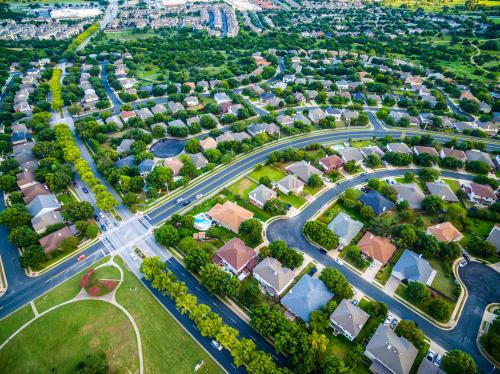In the year before COVID-19 swept the country, a smaller share of Americans changed residence than in any year since 1947, when the Census Bureau first started collecting annual migration statistics. This migration decline occurred during an upswing in the economy, when young adult millennials were beginning to get back on their feet after the Great Recession of 2007 to 2009. While no comparable migration statistics are available for the 10 months since the pandemic occurred, there now appears to be a new mix of migration patterns across different parts of the country, as evidenced by real estate, moving, and survey data suggesting selective migration upticks and downticks due to both safety and economic concerns.
Still, newly released pre-pandemic census statistics show a continuation of the decades-long migration decline, bringing the percentage of Americans who changed residence to a post-World War II low of 9.3%. This one-year rate—between March 2019 and March 2020—occurred on the heels of a year when the nation’s total population growth fell to a 100-year low, with a continued downturn in the nation’s foreign-born population gains. Thus, even before the pandemic, the nation was in the throes of stagnating demographic dynamics.
The new migration statistics draw from the Census Bureau’s Current Population Survey Annual Social and Economic Supplement, which has tracked American relocations since 1947. They allow for analyses of different kinds of domestic moves over that 73-year period, chronicling a continued stagnation of American mobility. Especially noteworthy are the migration declines for the nation’s young adult population, now mostly occupied by millennials.
The long pre-pandemic decline in American migration
U.S. migration trends show a fairly consistent decline since the late 1940s to 1960s, when approximately one-fifth of Americans changed residence annually. This was a period of economic growth and robust housing consumption, with a younger population than today. Afterwards began a gradual but sustained downturn in migration due to a variety of demographic and economic forces, including the rise of dual-earner households (making them less footloose), an aging population, and more homogenous labor markets emerging across the country. By the late 1990s, only about 15% to 16% of the population moved each year, dropping to 13% to 14% in the early 2000s.

Migration dropped even further—to the 11% to 12% range—after the Great Recession, no doubt reflecting the immediate impact of housing and labor market crashes. Since 2012, it has continued dropping to this year’s new low of 9.3%.
It is important to note that while both local moves (those within counties) and longer-distance moves (those across counties) have declined since the immediate postwar decades, their downturn has become more sustained since the recession and post-recession period. As shown in Figure 2a, local mobility hovered in the 8% to 9% range between 2005 and 2010. Since then, local mobility has plummeted to 5.4%. Because local moves comprise three-fifths of all moves, their consistent downward trend drove the overall pattern.
Since 2007 (the first year of the Great Recession), cross-county movement has hovered between 3.5% to 3.7%, as shown in Figure 2b. Prior to this, cross-county mobility levels were 4% or higher—including rates in the 5% to 6% range in the 1990s.

To better understand the downward trends in local and cross-county moves, it is useful to understand the different motivations for each. According to recent census surveys, more than half of local movers cite housing-related reasons such as the desire for new, better, or more affordable housing. Another quarter cite family reasons, including establishing a new household or a change in marital status.
A plurality of longer-distance movers, on the other hand, cite labor market reasons such as starting or relocating to a new job for their migration. Changes in the nation’s housing market and labor market both during and subsequent to the economically turbulent late 2000 to 2010 decade could have been responsible for migration declines for most of the 2010 to 2020 decade.
Millennials became stuck in place
While the migration slowdown occurred among most segments of the population, it is important to focus on young adults ages 18 to 34. This is historically the most mobile class of Americans, and can numerically drive the overall migration trend. But over the past decade, the millennial generation—a large portion of this group—has borne the brunt of housing and job crises that have deeply affected their mobility.
Figure 3 shows the rates of mobility by age in 2005 to 2006 and 2019 to 2020. It makes plain that young adults (the group with highest mobility rates in both years) showed the largest decline in those rates. For example, among young people ages 20 to 24, only 19% made a move between March 2019 and March 2020, down from 29% in 2005 to 2006. As the figure indicates, this downturn in mobility also affected the movement of children under age 18, who are largely the offspring of these young adults.


When focusing on annual changes in migration rates for 25- to 34-year-olds over this span, distinct patterns emerge for both local and cross-county migration (see Figures 4a and 4b). These patterns are broadly consistent with overall U.S. trends, and suggest that young adults are the driving force for them. Local migration for this age group dropped from a pre-2010 rate of 14% to 15% to a low of 10% in the year before the pandemic. Likewise, cross-county migration after 2006 hovers between 6% to 7%, down from rates of 8% or higher before.
Millennials moving into this age group were saddled with “stuck-in-place” issues associated with higher housing costs and underemployment, leading them to postpone key life events such as marriage, childbearing, and homeownership. And even though renters tend to move more frequently than owners, the rental market has become increasingly unaffordable. The new census data shows that annual migration rates of renter households have declined precipitously over time (from 30.2% in 2005 to 2006 to 17.7% in 2019 to 2020). On the other hand, cross-county migration trends for young adults—while not reaching pre-2006 levels—have fluctuated over the past decade.
Migration during and after the pandemic
A demographic stagnation has characterized the nation over the course of the 2010 to 2020 decade, alongside a downturn in within-U.S. migration right up to the beginning of the COVID-19 pandemic. Clearly some aspects of stagnation (lower immigration, more deaths, and lower birth rates) are likely to continue as the country struggles to cope with health and economic challenges. But what about internal migration? There is evidence of some immediate COVID-19-induced migration of residents fleeing some large cities, and others—including young adults—are seeking a safe haven by living with other family members. And after an initial dampening of housing markets, some parts of the country have experienced a market uptick.
But it is yet to be determined how permanent any of these pandemic-related migration patterns turn out to be. In the long run, after the widespread adoption of a vaccine and a more normal housing market prevails, migraton rates could continue to shift downward, as they have fairly consistently done over the past few decades. For example, increased telecommuting may reduce employment-related migration.
Much of this is now unknown. What is known is that internal migration in the last decade—and especially in the year before the pandemic—reached historic lows, particularly among young adults. These millennials and Gen Z youths are now in their peak migration ages, but the pandemic has hit them hard. Their future mobility—and that of upcoming generations—will tell us whether or not the country’s recent “immobility” will continue. If so, it would reinforce America’s demographic stagnation in ways that could further reduce dynamism in the nation’s housing and labor markets.
The Brookings Institution is committed to quality, independence, and impact.
We are supported by a diverse array of funders. In line with our values and policies, each Brookings publication represents the sole views of its author(s).







Commentary
Just before COVID-19, American migration hit a 73-year low
December 15, 2020